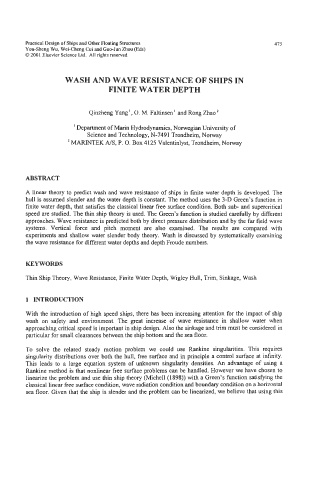Page 500 - Practical Design Ships and Floating Structures
P. 500
Practical Design of Ships and Other Floating Structures 475
You-Sheng Wu, Wei-Cheng Cui and Guo-Jun Zhou (a)
Q 2001 Elsevier Science Ltd. All rights reserved
WASH AND WAVE RESISTANCE OF SHIPS IN
FINITE WATER DEPTH
Qinzheng Yang‘ ,.O. M. Faltinsenl and Rong Zhao2
I Department of Marin Hydrodynamics, Norwegian University of
Science and Technology, N-749 1 Trondheim, Norway
’ MARINTEK NS, P. 0. Box 4125 Valentinlyst, Trondheim, Norway
ABSTRACT
A linear theory to predict wash and wave resistance of ships in finite water depth is developed. The
hull is assumed slender and the water depth is constant. The method uses the 3-D Green’s function in
finite water depth, that satisfies the classical linear free surface condition. Both sub- and supercritical
speed are studied. The thin ship theory is used. The Green’s function is studied carefully by different
approaches. Wave resistance is predicted both by direct pressure distribution and by the far field wave
systems. Vertical force and pitch moment are also examined. The results are compared with
experiments and shallow water slender body theory. Wash is discussed by systematically examining
the wave resistance for different water depths and depth Froude numbers.
KEYWORDS
Thin Ship Theory, Wave Resistance, Finite Water Depth, Wigley Hull, Trim, Sinkage, Wash
1 INTRODUCTION
With the introduction of high speed ships, there has been increasing attention for the impact of ship
wash on safety and environment. The great increase of wave resistance in shallow water when
approaching critical speed is important in ship design. Also the sinkage and trim must be considered in
particular for small clearances between the ship bottom and the sea floor.
To solve the related steady motion problem we could use Rankine singularities. This requires
singularity distributions over both the hull, free surface and in principle a control surface at infinity.
This leads to a large equation system of unknown singularity densities. An advantage of using a
Rankine method is that nonlinear free surface problems can be handled. However we have chosen to
linearize the problem and use thin ship theory (Michell(1898)) with a Green’s function satisfying the
classical linear free surface condition, wave radiation condition and boundary condition on a horizontal
sea floor. Given that the ship is slender and the problem can be linearized, we believe that using this

